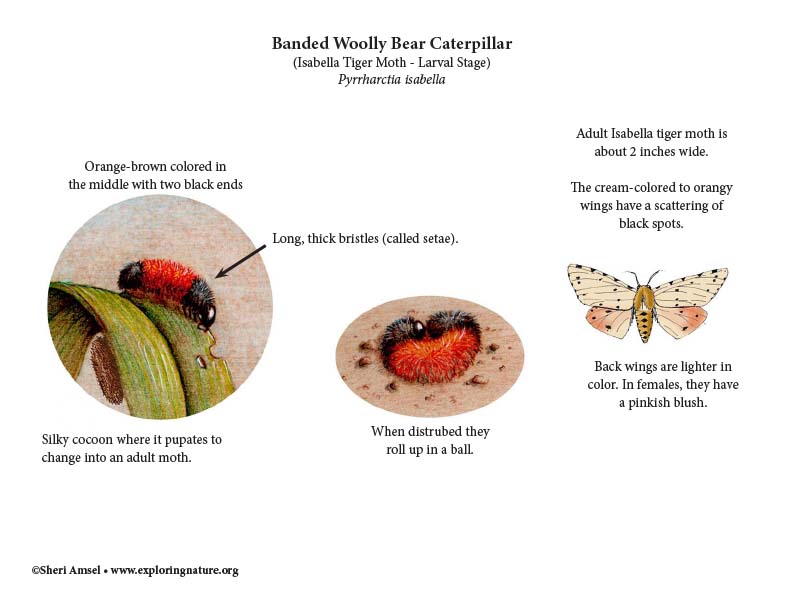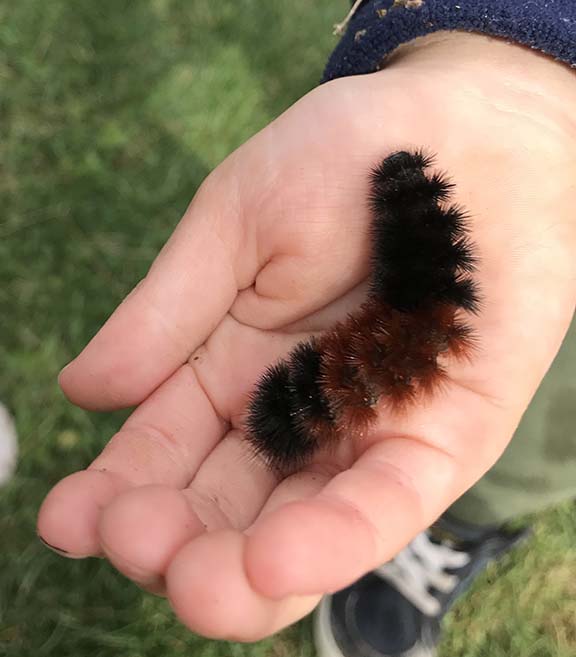

They are found in North America, Mexico and Canada.
They live in a variety of moist forests and meadows. They are least common in drier areas.
The woolly bear caterpillar has long, thick bristles (called setae). They are orange-brown colored in the middle with two black ends of varying widths. As they molt (and get bigger), the orange-brown band grows in width. They produce a chemical, called cryoprotectant, that allows their body to freeze over the winter without damaging their organs. The adult moth is about 2 inches wide with cream-colored to orangy wings that have a scattering of black spots. The back wings are lighter in color and in females have a pinkish blush.
Woolly bears spend much of the time warming up in sun. When they are warm enough, they can start feeding. When distrubed they roll up in a ball.
The larval stage (woolly bear caterpillars) eats the leaves of trees and a variety of plants.
They are insects that experience complete metamorphosis. The adult Isabella Moth lays eggs which hatch into the larval stage - the woolly bear caterpillar. The woolly bear feeds for a few weeks, then spins a silky cocoon where it “pupates” and develops into an adult moth to start the cycle over again. Generally, depending upon how warm or cold the climate, the woolly bear will complete a full life cycle early in the summer and by fall be in the second generation of larvae. They can over winter in the woolly bear stage, freezing and going dormant. They then thaw in the spring and start feeding again. They may even do this for several winters before pupating. The shortest phase is the adult phase. Once an adult hatches out of their cocoon as an Isabella moth, it mates, lays eggs and dies within 24 hours.
Check out the Life Cycle Diagram.
They are thought to have the longest life of any moth or butterfly. They may live upward of 10 years.
Domain Eukarya
Kingdom Animalia
Phylum Arthropoda
Class Insecta
Order Lepidoptera
Superfamily Noctuoidea
Family Erebidae
Genus Pyrrharctia
When you research information you must cite the reference. Citing for websites is different from citing from books, magazines and periodicals. The style of citing shown here is from the MLA Style Citations (Modern Language Association).
When citing a WEBSITE the general format is as follows.
Author Last Name, First Name(s). "Title: Subtitle of Part of Web Page, if appropriate." Title: Subtitle: Section of Page if appropriate. Sponsoring/Publishing Agency, If Given. Additional significant descriptive information. Date of Electronic Publication or other Date, such as Last Updated. Day Month Year of access < URL >.
Amsel, Sheri. "Banded Woolly Bear Caterpillar (Isabella Tiger Moth - Larval Stage)" Exploring Nature Educational Resource ©2005-2024. December 13, 2024
< http://www.exploringnature.org/db/view/Banded-Woolly-Bear-Caterpillar-Isabella-Tiger-Moth-Larval-Stage >


